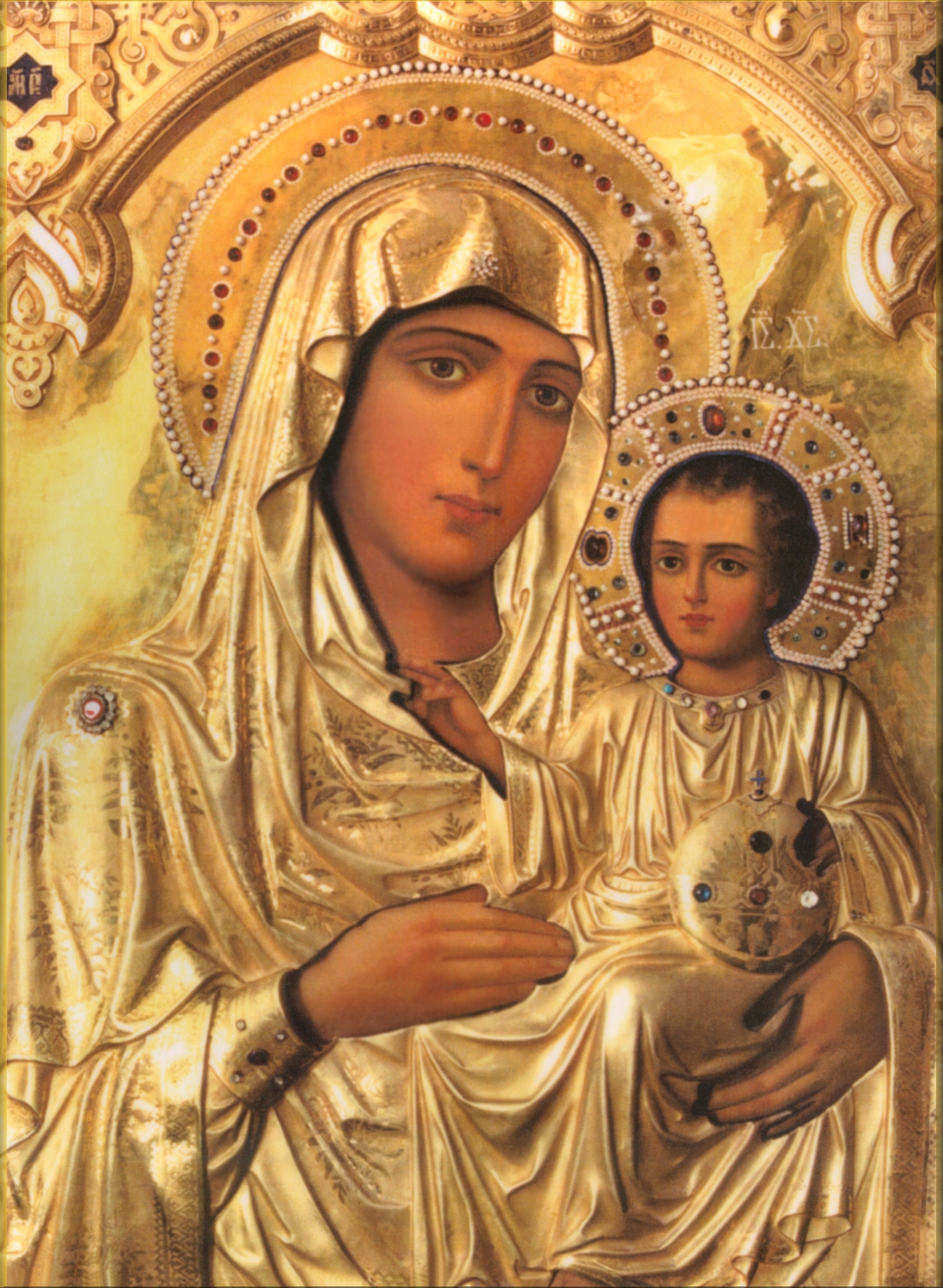
 The Council of Ephesus  "Behind the Scenes" "Behind the Scenes"
by Mark Alessio Part 2  Six more sessions would be held in Ephesus, the final session of the Third Ecumenical Council meeting on July 31. As it turned out, there was still some drama to be gleaned from the proceedings, beginning with the arrival of John of Antioch in Ephesus on June 27. No sooner had John arrived, surrounded by armed guards, when he called together his own assembly and, accusing St. Cyril of Arian and Apollinarian heresies, proclaimed both him and Memnon, Bishop of Ephesus, "excommunicated!" As a result, 43 bishops deposed Cyril, and the other members of the council were asked to condemn the Twelve Anathemas listed in Cyril's letter to Nestorius, which had been approved by the Council. The Emperor, in a desperate and ill-conceived attempt to restore order, had Cyril, Memnon and Nestorius arrested. Cyril and his followers, as well as the followers of other bishops also accused of heresy, petitioned Rome, while Emperor Theodosius called for a new session to handle this new development, thereby overstepping his bounds even as a Catholic ruler by, in effect, declaring the original, authentic Council null. A message was finally smuggled out of Ephesus to Constantinople, hidden in a hollow cane carried by one of Cyril's men disguised as a beggar. The abbot who received this communication took to the streets of Constantinople with a huge retinue of monks and lay people, who advanced to the Emperor's palace, where the abbot was able to speak to Theodosius. His goal was to free Cyril and Memnon, and urge the Emperor to accept the decrees of the authentic Council. When the contents of the letter were finally read aloud to the public in church, everyone shouted "anathema to Nestorius!" Obviously, indifference to theological matters was not a characteristic of the times! The Emperor, still straddling the fence, sent an order summoning all the parties in the conflict to meet with him in Constantinople. However, right after issuing this official summons, Theodosius relented and gave his full support to the decrees of the authentic Council. There can be little doubt that the "credit" for his change of heart belongs to his sister, Pulcheria. A capable woman, who had served as her brother's regent for a time, Pulcheria is known and revered by Catholics today as Saint Pulcheria. [+453] As a girl, she had consecrated her virginity to God and, as the chaste wife of Emperor Marcian, she built three churches in Constantinople dedicated to the Blessed Virgin, in addition to hospitals and other charitable establishments. Pulcheria's influence with Theodosius was strong, and it seems somehow fitting that, in the midst of all the clamor and unrest occurring in Ephesus, Our Lady would employ such a holy woman to help defend her title, Theotokos. The Second Session of the Council of Ephesus met on July 10, the date of the arrival of envoys from Rome. Philip, the Papal representative, presented a new letter from Pope Celestine ratifying his earlier declaration by which Nestorius would suffer excommunication and lose his Seat should he fail to recant his heresy within ten days of receiving the Apostolic judgment. The Council Fathers accepted this news, praising both Celestine and Cyril as guardians of the faith, praising each man as a "new Paul". On the following day, July 11, a Third Session met so that the condemnation of Nestorius could be read in the presence of the papal legates and confirmed by them in the name of the Pope. The official Acts of the first three Council Sessions were then signed by the legates, a letter was sent to the Emperor informing him of the outcome of the proceedings, and it was decreed that a new bishop be chosen to replace Nestorius as Patriarch of Constantinople. The fourth, fifth, sixth and seventh sessions of the Council had dealt with various matters, such as the accusations of John of Antioch, the passing of canons against "Nestorian" priests, and various juridical matters. During the Sixth Session, it was decreed that no one should attempt to compose any Creed other than the Nicene Creed, upon pain of anathema [to a layman] or deposition [to a cleric]. The Council of Ephesus was dissolved in October and confirmed by Pope Sixtus III [432-440], Celestine having died before the close of the synod, but not before capping his pontificate by sending St. Patrick to preach the Gospel to the people of Ireland. In 433, John of Antioch helped to reconcile the Patriarchates of Alexandria and Constantinople by signing a declaration condemning Nestorius, who had retired to his monastery, but was exiled to Egypt in the year 436, where he remained until his death [and where, at one point, he was taken captive by the Nubians]. The Emperor Theodosius ordered the destruction of Nestorius' writings. At approximately the same time as Nestorius' death, the Council of Chalcedon [451 A.D.] affirmed the doctrine that two natures are united in Christ, by accepting the letters which St. Cyril had earlier written to Nestorius. Our Lady's title, "Mother of God," was also defended in a letter of Pope St. Leo the Great, [440-461] accepted by that Council, which described Jesus Christ as "begotten before the ages from the Father as regards "His Divinity, and in the last days the same for us and for our salvation from Mary, the virgin God-bearer [Theotokos] as regards His humanity; one and the same Christ, Son, Lord." And what became of St. Proclus, who had praised Our Lady's Divine Maternity in such glowing terms on that long-ago day in the cathedral of Constantinople? Six years before the Council of Ephesus had taken place, Proclus had been a strong candidate to succeed Atticus as Patriarch of Constantinople upon the death of the latter, but he was passed over in favor of Sissinius. Two years later, [in 427] Sissinius died and, once again, it looked as though Proclus would ascend to the patriarchate. However, this time it was Nestorius who became the new Patriarch. After Nestorius was deposed in 431, it seemed certain that the new Patriarch of Constantinople would be the worthy Proclus. However, certain persons who, perhaps, did not wish to see Proclus thus favored intervened against his appointment. The "anti-Proclus" party claimed that, under canon law, a person nominated to one bishopric can not be translated to another, and Proclus had once been nominated as Archbishop of Cyzicus [although, since the people of Cyzicus had already nominated their own bishop, Proclus did not assume the office]. As a result, Nestorius was immediately succeeded by a priest named Maximian. However, after the death of Maximian in 434, St. Proclus at last became the Patriarch of Constantinople, and it is certain that his flock were quite content to see this staunch defender of Mary's dignity reigning in their city. "The More Things Change . . ." To those Catholics who have studied the background of the Second Vatican Council, with its various factions and agendas, it may seem odd at first to observe how many subterfuges and machinations operated beneath the surface of an ancient Council, convened at a time before the words "modernist" and "traditionalist" entered into Catholic parlance. Yet, the early ages of the Church were rife with heresies, and these heretical ideas were not the whims of men who grew tired of following the ancient Faith or bored with obedience to the dictates of doctrine and practice [which would account for the "human" element of the later Protestant Revolt, bolstered as it was by the diabolical]. On the contrary, in the early Church, erroneous ideas were spread oftentimes by renowned theologians, respected orators and scholars, who presented detailed theological writings in support of them. While these false teachers were not called "modernists", they were known as what we might call the ancient equivalent of the term "modernist". They were known as promoters of novelty. An Ecumenical Council is serious business, meant to safeguard, defend, and explain the Catholic Faith. If it fails in this duty, then it has failed in charity towards the faithful and is, then, little more than "sounding brass, or a tinkling cymbal". Despite the human drama surrounding the Council of Ephesus, the fact remains that the Council met for one reason: to shed the light of Truth on the darkness of Error. A heresy had been promulgated, an outcry [by both layfolk and clerics] had ensued, and action was then taken. When the Council Fathers of Ephesus defended the Nicene Creed during their Sixth Session, they declared that:
Furthermore, the Council Fathers stated that there can be no extenuating circumstances justifying novelty in doctrine, even in the case of those who believe that such novelties might help to make a favorable impression on those outside the Church [i.e., "for the benefit of those who wish to turn from Hellenism or Judaism or some other heresy to the knowledge of the truth"]. To alter doctrine in order to make Catholicism more "acceptable" to those outside the Church is to make a mockery of Divine Revelation; therefore, there can be no good "excuse" to tamper with doctrine . . . period! This unalterable fact alone condemns the false "ecumenism" spawned by deceived or deceitful Catholic clerics during the last quarter of the 20th Century and charging ahead today with no apparent limit to its excesses. "Mother of God" It is a common notion to summarize the Council of Ephesus as the event "where Mary's title, Mother of God, was defended and solemnly proclaimed." This is, of course, true. But a look at the council documents gives us a very keen insight into the unique relationship which existed, still exists, and always will exist between "Marian" doctrines and the fundamental Truths of the Catholic Faith. There is a reason why Our Lady is regarded as a "litmus test" for doctrinal orthodoxy. There is a reason why a person's regard for Mary is a clear indication of his regard for Jesus. There is a reason why Catholics see the Son and the Mother as related not only by a physical/emotional bond, but also in a theological sense that colors all proper understanding of both Scripture and doctrine. The documents of the Council of Ephesus do not regard Our Lady apart from Her relationship to Her Divine Son. The letters of St. Cyril are not epistles or homilies on Mary's beauty, or Her courage, or Her powers of mediation, all of which have been praised ceaselessly and eloquently from the time of the Fathers down to the present. The intent of the Council Fathers was, simply, to defend the integrity of the Incarnation. The focal point of the Council-----indeed, the focal point of all sound theology and devotion-----is the Person of Jesus Christ, True God and True Man. The Council Fathers of Ephesus accomplished their goal of defending the integrity of the Incarnation by defending the correct doctrine handed down to them, namely, that through the hypostatic union [or "Unity of Person"], Divine and human natures were united [and not merely combined] in the One Person of Jesus Christ. And what was the one, critical element of this doctrine, the one element which stood like an impenetrable barrier to any and all false teachings about Jesus? What was the element without which Nestorius' errors might have seemed plausible? What unique element stood shining like a beacon to defend the truth of the Incarnation? St. Proclus knew. St. Cyril knew. Pope Celestine knew. The Ephesians knew. The Blessed Virgin Mary-----the one and only Theotokos-----is this beacon. Imagine, for a moment, that Nestorius had been correct, and that there was no actual unity of Divine and human natures in Christ. What would the Sacrifice of the Cross have meant then? Mankind owed a debt to God because of the transgression of our first parents in Eden. Through Christ's human nature, humanity was able to atone for the offense incurred by humanity. Through His Divine nature, this atonement was of infinite merit, and therefore acceptable to the Father. Because, as St. Paul taught, Our Lord was made "of the seed of David, according to the flesh," His Sacrifice was not a mere display. That is to say, God did not simply "pretend" to suffer and die, in order to redeem His creatures. But, instead, as St. Cyril wrote to Nestorius, it is a fact that Our Lord "suffered death for us, not as if He Himself had experienced death as far as His own nature was concerned [it would be sheer lunacy to say or to think that], but because, as I have just said, His flesh tasted death." Because of the Unity of Person denied by Nestorius, the Justice of God was not mocked or compromised, even as His Mercy towards suffering mankind was made manifest in a wonderful manner. Because of this Unity of Person, it can truly be said that:
And what was the "cornerstone" of this world-altering occurrence? It is very interesting to note that, since the days of the early Church Fathers, the virgin soil of Eden [from which was formed the "First" Adam] was seen as a foreshadowing of the Blessed Virgin [from whom was formed the "Second" Adam]:
There is one last consideration to take into account when pondering the awesome title, Theotokos. God deigned to redeem humanity by the most extraordinary display of mercy ever seen since Time began . . . the suffering and death of the Second Divine Person made man. For this Sacrifice to be real, the Redeemer had to be "like as we are, without sin." [Heb. 4: 15] The Infant Jesus had to be given to the world by a human Mother, just as each person reading these words was given to the world by a mother. Our Lord was born on the first Christmas night because His Mother had said "yes" to the Archangel Gabriel nine months before. And, as difficult as it may seem for heretics of various stripes to comprehend, the Divine Infant would NOT have been born on that day had Mary refused the role of Theotokos. How, then, would humanity have been redeemed? Would humanity have been redeemed at all? These are pointless questions, for we are told one thing and one thing only in the inspired texts: "For God so loved the world, as to give His only begotten Son: that whosoever believeth in Him may not perish, but may have life everlasting." [Jn. 3: 16] This is what we know. God chose the Incarnation as the means of our salvation. The Blessed Virgin would be asked to accept Her role in this grand event, in order for things to be fulfilled. The very last words spoken by Gabriel before Mary gave Her fiat were, "Because no word shall be impossible with God." There was no coercion here. The Archangel was asking for Our Lady's consent. Because Mary did pronounce Her fiat at the Annunciation, God's plan from the dawn of creation was brought to fruition. Because She freely and lovingly said yes, "the Word was made flesh and dwelt among us." Is it any wonder, then, that Catholics have treasured that precious "fiat", and the Woman who spoke it, down through the ages, understanding that we owe a profound debt of gratitude to the Blessed Virgin?
Reprinted from the May 2002 Issue of Catholic Family News. 
HOME-----------MARY'S
INDEX--------------PRINT THE IMAGE OF OUR
LADY OF JERUSALEM |

